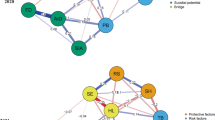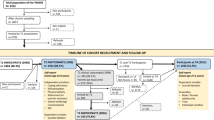Abstract
This study examined the longitudinal relationship between family characteristics in early childhood, self-esteem, hopelessness and thoughts of self-harm in the midchildhood years, and suicidal ideation at ages 18 and 21. Path analysis was used to establish separate models for boys and girls. The results suggested different pathways to later suicidal ideation for boys and girls. For boys, suicidal ideation seemed to have stronger roots in childhood, with significant paths from low self-esteem and hopelessness to early thoughts of self-harm and thence to later ideation. For girls, self-esteem had a small but significant direct effect on later suicidal ideation. The findings provide support for the idea that individual characteristics such as feelings of hopelessness and low self-esteem act as “generative mechanisms,” linking early childhood family characteristics to suicidal ideation in early adulthood.
Similar content being viewed by others
REFERENCES
Abernathy, T. J., Massad, L., & Romano-Dwyer, L. (1995). The relationship between smoking and self-esteem. Adolescence, 30, 899-907.
American Collaborative Study of Cerebral Palsy, Mental Retardation and Other Sensory Disorders of Infancy and Childhood. (1966). Manuals: Behavioral examinations (Part III-D). Bethesda, MD: U.S. Departments of Health, Education and Welfare, National Institutes of Health.
Anderson, J., Williams, S., McGee, R., & Silva, P. A. (1987). DSM-III disorders in pre-adolescent children: Prevalence in a large sample from the general population. Archives of General Psychiatry, 44, 69-76.
Bosma, H., van de Mheen, H. D., & Mackenbach, J. P. (1999). Social class in childhood and general health in adulthood: Questionnaire study of contribution of psychological attributes. British Medical Journal, 318, 18-22.
Cohen, J., & Cohen, P. (1983). Applied multiple regression/correlation analysis for the behavioral sciences (2nd ed.). Hillsdale, NJ: Erlbaum.
Costello, A., Edelbrock, C., Kalas, R., Kessler, M., & Klaric, S. A. (1982). Diagnostic interview schedule for children—DISC. Bethesda, MD: National Institute of Mental Health.
Demo, D., & Savin-Williams, R. C. (1983). Early adolescent self-esteem as a function of social class. American Journal of Sociology, 88, 763-774.
Farrington, D. P., & Loeber, R. (1998). Transatlantic replicability of risk factors in the development of delinquency. In P. Cohen, C. S. Slomkowski, & L. N. Robins (Eds.), The influence of history and geography on aspects of psychopathology. Mahwah, NJ: Erlbaum.
Feehan, M., McGee, R., Stanton, W. R., & Silva, P. A. (1991). Strict and inconsistent discipline in childhood: Consequences for adolescent mental health. British Journal of Clinical Psychology, 30, 325-331.
Fergusson, D. M., & Lynskey, M. T. (1995). Childhood circumstances, adolescent adjustment, and suicide attempts in a New Zealand birth cohort. Journal of the American Academy of Child and Adolescent Psychiatry, 34, 612-622.
Frost, L. A., Moffitt, T. E., & McGee, R. (1989). Neuropsychological correlates of psychopathology in an unselected cohort of young adolescents. Journal of Abnormal Psychology, 98, 307-313.
Garber, J., Little, S., Hilsman, R., & Weaver, K. R. (1998). Family predictors of suicidal symptoms in young adolescents. Journal of Adolescence, 21, 445-457.
Garrison, C. Z., Addy, C. L., Jackson, K. L., McKeown, R. E., & Waller, J. L. (1991). A longitudinal study of suicidal ideation in young adolescents. Journal of the American Academy of Child and Adolescent Psychiatry, 30, 597-603.
Hewitt, P. L., Newton, J., Flett, G. L., & Callander, L. (1997). Pefectionism and suicidal ideation in adolescent psychiatric patients. Journal of Abnormal Child Psychology, 25, 95-101.
Holahan, C. J., & Moos, R. H. (1983). The quality of social support: Measure of family and work relationships. British Journal of Clinical Psychology, 22, 157-162.
Joiner, T. E., & Rudd, M. D. (1996). Disentangling the interrelations between hopelessness, loneliness and suicidal ideation. Suicide and Life-Threatening Behavior, 26, 19-26.
Juon, H. S., & Ensminger, M. E. (1997). Childhood, adolescent, and young adult predictors of suicidal behaviors: A prospective study of African Americans. Journal of Child Psychology and Pychiatry, 38, 553-563.
Kashani, J., McGee, R., Clarkson, S. E., Anderson, J. C., Walton, L. A., Williams, S. M., Silva, P. A., Robins, A. J., Cytryn, L., & McKnew, D. H. (1983). Depression in a sample of nine year old children: Prevalence and associated characteristics. Archives of General Psychiatry, 40, 1217-1223.
Klimes-Dougan, B., Free, K., Ronsaville, D., Stilwell, J., Welsh, C. J., & Radke-Yarrow, M. (1999). Suicidal ideation and attempts: A longitudinal investigation of children of depressed and well mothers. Journal of the American Academy of Child and Adolescent Pychiatry, 38, 651-659.
Leadbeater, B. J., Kupermine, G. P., Hertzog, C., & Blatt, S. J. (1999). A multivariate model of gender differences in adolescents' internalizing and externalizing problems. Developmental Psychology, 35, 1268-1282.
Lewinsohn, P. M., Rohde, P., & Seeley, J. R. (1994). Psychosocial risk factors for future adolescent suicide attempts. Journal of Consulting and Clinical Psychology, 62, 297-305.
Levy, S. R., Jurkovic, G. L., & Spirito, A. (1995). A multisystems analysis of adolescent suicide attempters. Journal of Abnormal Child Psychology, 23, 221-234.
Loeber, R., Drinkwater, M., Yin, Y., Anderson, S. J., Schmidt, L. C., & Crawford, A. (2000). Stability of family interaction from ages 6 to 18. Journal of Abnormal Child Psychology, 28, 353-369.
Luthar, S. S. (1999). Poverty and children's adjustment. Thousand Oaks, CA: Sage.
McGee, R., Anderson, J., Williams, S., & Silva, P. A. (1986). Cognitive correlates of depressive symptoms in 11-year-old children. Journal of Abnormal Child Psychology, 14, 517-524.
McGee, R., & Williams, S. (1999). Environmental risk factors in oppositional defiant disorder and conduct disorder. In H. C. Quay & A. E. Hogan (Eds.), Handbook of disruptive behaviour disorders. New York: Plenum Press.
McGee, R., & Williams, S. (2000). Does low self-esteem predict health compromising behaviors among adolescents? Journal of Adolescence, 23, 569-582.
Moscicki, E. K. (1995). Suicide in childhood and adolescence. In F. C. Verhulst & H. M. Koot (Eds.), The expidemiology of child and adolescent psychopathology. Oxford: Oxford University Press.
Nada-Raja, S., McGee, R., Feehan, M., Langley, J., & Williams, S. (1998). Suicidal ideation and attempts in early adulthood in a community sample: Prevalence and risk factors: [Abstract]. In R. J. Kosky, H. S. Eshkevari, R. D. Goldney, & R. Hassan (Eds.), Suicide prevention: The global context. New York: Plenum Press.
Nunnally, J. C. (1967). Psychometric theory. New York: McGraw-Hill.
Overholser, J. C., Adams, D. M., Lehnert, K. L., & Brinkman, D. C. (1995). Self-esteem deficits and suicidal tendencies among adolescents. Journal of the American Academy of Child and Adolescent Psychiatry, 34, 919-928.
Roberts, R. E., Roberts, C. R., & Chen, Y. R. (1998). Suicidal thinking among adolescents with a history of attempted suicide. Journal of the American Academy of Child and Adolescent Psychiatry, 37, 1294-1300.
Robins, L. N., Helzer, T. E., Cottler, L., & Goldring, E. (1989). NIMH Diagnostic Interview Schedule: Version III Revised. Bethesda, MD: National Institute of Mental Health.
Rosenberg, M. (1965). Society and the adolescent self-image. Princeton, NJ: Princeton University Press.
Rosenberg, M., & Pearlin, L. I. (1978). Social class and self-esteem among children and adults. American Journal of Sociology, 84, 53-77.
Rutter, M. (1978). Family, area and school influences in the genesis of conduct disorders. In L. A. Hersov, M. Berger, & D. Shaffer (Eds.), Aggression and anti-social behaviour in childhood and adolescence. Oxford: Pergamon Press.
Rutter, M. (1989). Pathways from childhood to adult life. Journal of Child Psychology and Psychiatry, 30, 23-51.
Rutter, M., Tizard, J., & Whitmore, K. (1970). Education, health and behaviour. London: Longmans.
Schaefer, R. S., & Bell, R. W. (1958). Development of a parental attitude research instrument. Child Development, 29, 339-361.
Silva, P. A., & McCann, M. (1996). An introduction to the Dunedin study. In P. A. Silva & W. R. Stanton (Eds.), From child to adult: The Dunedin Multidisciplinary Health and Development Study. Auckland: Oxford University Press.
Stanton, W. R., McGee, R., & Silva, P. A. (1991). Indices of perinatal complications, family background, child rearing, and health as predictors of early cognitive and motor development. Pediatrics, 88, 954-959.
Stanton, W. R., & Silva, P. A. (1992). The parental attitude research instrument: An approach to use of attitude questionnaires. Early Development and Parenting, 1, 121-126.
Williams, S., McGee, R., Olaman, S., & Knight, R. (1997). Level of education, age of bearing children and mental health of women. Social Science and Medicine, 45, 827-836.
Author information
Authors and Affiliations
Rights and permissions
About this article
Cite this article
McGee, R., Williams, S. & Nada-Raja, S. Low Self-Esteem and Hopelessness in Childhood and Suicidal Ideation in Early Adulthood. J Abnorm Child Psychol 29, 281–291 (2001). https://doi.org/10.1023/A:1010353711369
Issue Date:
DOI: https://doi.org/10.1023/A:1010353711369




